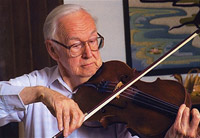UW geneticist remembered as his papers are read
In a conference room in the Genetics/Biotech Building on campus, a small group gathers for a weekly discussion of a journal article.

Crow plays his viola.
Although the typical “journal club” attracts grad students who devour the latest reports from their sub-specialty, this club is reading a study of the high rate of genetic mutations among children of older fathers. The paper was published 15 years ago by James Crow, a famed UW–Madison geneticist who died in January at age 95.
As the discussion meanders from men to yeast to fruitflies, touching on the rate at which mutations appear and then are removed from the sperm and the human genome, it’s clear that Crow had chosen a topic that would engage his broad interests in population genetics and the history of genetic science.
Nobody can find an error in the article, although some of the questions Crow raised still beg for answers in 2012.
In genetics, a decade-and-a-half is an eon, but there are reasons to read Crow’s articles, even if they are slightly dated. “Jim had a way of bringing so many things together into the big picture, that would allow him to come up with a big conclusion,” says Rayla Temin, who received a Ph.D. from Crow in 1963, and is now professor emerita of genetics.
Crow taught or collaborated with many of the biggest names in his field. His groundbreaking research touched mathematical genetics, inbreeding, genetic effects of pesticides and radiation, natural variations in populations, sex determination, plant and animal breeding, selfish genes, and the impact of mutations on populations.
Kind, considerate, and an excellent storyteller, Crow was a revered figure on campus and is memorialized via the James F. Crow Institute for the Study of Evolution, which unites evolution researchers from across the campus.
Crow was also an accomplished musician who played viola in the Madison Symphony Orchestra for 45 years.
Despite the pace of change — the equipment used to analyze genes, for example, has capabilities that could barely be imagined 15 years ago — Crow’s papers remain significant, says Andrew Hasley, a graduate student in genetics. “I like science history, and Jim was there for a lot of it.” His fellow Ph.D. students, he adds, “are taught that genetics is a method, a system of logic, a way of thinking. And that comes out in Jim’s writing. It’s instructive and it’s good for my education.”


